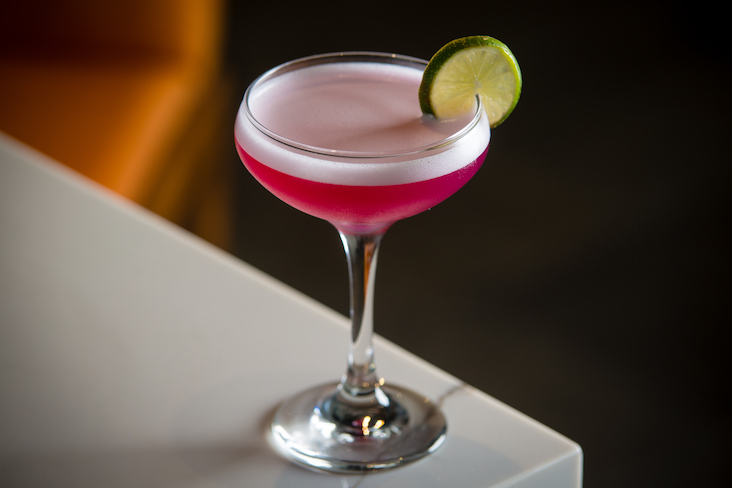Chardonnay is the best-selling wine varietal, at every type of restaurant/bar operation in every major U.S. market, according to the 2012 Cheers OnTrac Bar Managers Study. It has been for several years.
It’s not hard to see why: Winemakers like it because chardonnay is a blank canvas; its neutrality allows them to put their own stamp on it. And while it originated in Burgundy, chardonnay is now grown practically everywhere in a variety of soils and climates.
Consumers love chardonnay because it’s tasty, easy to drink and easy to say. It became the default white wine order for many people during the past two decades.
But chardonnay’s massive appeal and popularity inevitably led to a backlash. Wine snobs shunned it, prompting the ABC—anything but chardonnay—sentiment that was identified by Frank Prial of the The New York Times in 1995.
That’s in part why chardonnay’s share of total market has slipped steadily from more than 50% in 2003 to 41% in 2009 to 32% in 2012, according to the OnTrac survey data.
It’s still by far the most popular wine, though, and even many of its detractors are coming back to chardonnay. We spoke to sommeliers from around the country at a variety of different concepts to find out the state of chardonnay.
AGAINST THE OAK
After chardonnay’s popularity soared in the U.S. in the 1980s, many California chardonnays started to taste the same. Big, buttery flavors heavy on the oak and vanilla began to define the varietal, causing some wine drinkers to move away from chardonnay. Many winemakers in recent years have pulled back on the oak to showcase more of chardonnay’s fresh, fruit qualities. “In the 1990s, customers wanted big, buttery and oaky,” says Brian Duncan, wine director at Bin 36 restaurant in Chicago, “but at some point the pros decided it wasn’t cool to like that style.”
Perhaps today it’s more about oak than it is about chardonnay as a whole, Duncan: “Today people are asking for unoaked wine—it’s either a preference or a trend.”
Even at a more traditional concept like The Metropolitan steakhouse in Seattle, “people have heard oak is bad,” says Master Sommelier Thomas Price.
CUSTOMER CONFUSION
Beyond arguably irrational prejudice, another issue facing chardonnay is customer confusion due to the variety of styles and names of wines. “It’s a shock for some when they learn chablis is chardonnay,” says Duncan.
Virginia Philip, wine director and Master Sommelier at The Breakers in Palm Beach, FL, agrees. “We have guests who say they want a glass of chablis not realizing it’s chardonnay, while in the 1990s people ordered pouilly-fuisse, also not realizing it was chardonnay.”
Blends add to the confusion. “Chardonnay is one of the vines on every continent and region,” says Jacob Fairchild, director of wine sales for Lasco Enterprises, operator of Texas-based casual concepts Max’s Wine Dive and the Tasting Room. “In Spain and South America, winemakers sometimes add it to blends and consumers don’t always realize chardonnay is even in the blend they’re drinking.”
One of the biggest misconceptions is that chardonnay represents a single style that some people may think they dislike. Nothing could be further from the truth.
When Duncan hears customers castigate chardonnay, his response is usually “From where? Because it’s all about location, soil type and winemaker.”
The fact that chardonnay comes in many styles should be an advantage. “I think you’ll find there’s something for everybody,” says Duncan. “I’m a big fan of Burgundy, and wines from Oregon and Washington and California.”
But even California isn’t monolithic, he notes. For instance, “in Santa Lucia, you get tree fruit and stone fruit; from Carneros, some mineral-driven chardonnay. Those are some of the areas that are more obvious.”
Price of The Metropolitan likens chardonnay to syrah in that “it takes on its own characteristics based on the terroir and who’s making it.”
STYLES AND REGIONS
At Lasco’s, the operator’s main selection of chardonnay varies between California and France, which offers “more linear, acidic and citrusy wines,” Fairchild says. “So that way we hit both.” He also offers a South African chardonnay.
The Breakers looks for “wines with oak and some minimal oak. Some people prefer no oak,” Philip says. “By having two different styles we can do both.”
Philip sources chardonnay globally, so The Breakers’ entry chardonnay could be domestic—she favors Oregon and Washington—or Australian or Chilean. “Chile is producing a solid chardonnay with crisp minerality without being overloaded with alcohol.” (See “A Sample of Chilean Chardonnays” below.) She also likes Mendoza in Argentina, and “France will always be heart and soul for chardonnay.”
At Celebrity Cruises, the chardonnay selection runs the gamut, says Chanelle Duarte, manager of beverage development. “We have a vast amount of burgundies, also South America, South Africa, Italy, some Tuscan, Spanish—mostly blends.”
Guests at The Metropolitan often gravitate to the familiar California chardonnays like Far Niente and Cakebread. But Price says he offers a broad range of styles. “I’ve added a lot of white burgundies, chablis is tough to beat and Montrachet gives you more oak and puligny for acid and balance,” he notes.
In addition to Cote de Beaune and cooler-climate chardonnay from France’s Jura region, which Price says has hardly any oak and is very linear, he looks to Australian chardonnays from places like Victoria.
He is encouraged by improvements being made by Italian and Spanish winemakers and some of the chardonnay coming from Chile and Argentina. Price also likes some of the cooler-climate areas in California such as Carneros and the Russian River as well as Washington state.
Duncan says he’s been impressed with some of the chardonnays from Germany, and “some Italian ones are pristine. South America is awakening with a range of styles, and I think there’s more to come.”
MARKETING CHARDONNAY
Given chardonnay’s popularity, it’s generally not too hard to sell. But with the preconceived notions and misconceptions about the varietal, a little care when promoting chardonnay can go a long way.
Beyond offering a range of styles and price points, operators have several ways to showcase chardonnay. At Bin 36, pairing wine with food is a staple: “We pair it with dishes on the menu and cheeses,” says Duncan. “We have a preference for cheese with chardonnay.”
The Breakers takes a consultative approach to marketing the wine. “We have descriptions of the wines, what it should taste like, and tasting notes for the staff,” says Philip. “We ask guests if they like light-, medium- or full-bodied wines and go from there.”
Celebrity Cruises will market the varietal experientially, making chardonnay a part of various enrichment programs to introduce people to different varieties. “For example, we offer [Kendall-Jackson] Vintners Reserve chardonnay, a classic California style, and a Wente chardonnay to see how each interacts with the food,” says Duarte. “We do a walk-around tasting, similar to a grand tasting, with 20 or so bottles that are not usually sold by the glass.”
Max’s Wine Dive and the Tasting Room are both informal about tasting to “allow people to explore their palate,” says Fairchild. The idea is to let people try before they buy to help them get over any bias about the varietal, he notes. “We will suggest an unoaked or French chardonnay, and they can be surprised by it.”
There are two basic chardonnay drinkers today, Fairchild says: those who want the “butter bomb, apple pie,” and those “who are turned off by that, but like an unoaked chardonnay or one with bright citrus and apple.”
Unoaked Argentinean chardonnay is currently doing well among Celebrity Cruises’ guests, Duarte says. “It’s not buttery or oaky; it’s citrusy.” Overall the category has seen a tremendous change “from super buttery and oaky, to a cleaner, fresher, crisper style,” she says. “It’s easier drinking—that’s the direction we’ve decided to go.
Regardless of the popularity of one style over another, chardonnay seems poised to stay at the top, partly due to its flexibility. “It’s such an easy wine to drink and pair with food,” says Duarte.
On the flip side, Price says chardonnay is “the ultimate cocktail wine,” that can often be enjoyed without food.
Responding to what customers want is key, but leading the way is also important. Price stresses the importance of “offering wines that sommeliers and wine directors are passionate about, but also wines that are accurate depictions of their style.”
Wine professionals and those in the industry “can be card-carrying members of the ABC club, and that in turn makes consumers suspicious,” Duncan says. “We need to not feed the chardonnay bashing and prejudice.”
But many say the bias against chardonnay is fading on its own. “Every once in a while, we see the prejudice” against chardonnay, says Fairchild. “But it’s kind of like what happened with merlot: People moved away then came back to it.”
Amy Sherman is a San Francisco-based writer, recipe developer, and restaurant reviewer. She is the editor of the award-winning food blog Cooking with Amy and is author of WinePassport: Portugal and Williams-Sonoma New Flavors for Appetizers.
TIPS FOR SELLING CHARDONNAY
While chardonnay tends to sell well on its own, some people do have a bias against the wine, often because they don’t understand the varietal’s different styles. Here are five tips for marketing chardonnay.
1) List chardonnay by flavor to help educate customers about the range of styles.
2) Offer some traditional French chardonnay so customers can experience the classics.
3) Go beyond Napa Valley in California, and consider other regions such as Russian River, Santa Cruz and Santa Barbara.
4) Include at least one non-oaked chardonnay on the by-the-glass list, and be sure to describe it as such.
5) Suggest food pairings with chardonnay, since the acidity makes it a great food wine.—AS
A SAMPLE OF CHILEAN CHARDONNAYS
Chile is one of the up-and-coming wine producers for several varietals, including chardonnay. The country offers a diverse growing climate, and the wines from Chile are often excellent values. Here are a few Chilean chardonnays to consider.
Amayna 2010 (Leyda Valley) $28; enhanced citrus flavors, savory mineral finish.
Cono Sur Single Vineyard 2012 (Casablanca Valley) $18-$20; citrus freshness, melon, honey, just enough oak wood flavor.
Emiliana Organic Vineyards Natura 2012 (Casablanca Valley) $10.99; fresh, fruit-forward (citrus and tropical) with velvety texture.
Lapostolle 2011 (Casablanca Valley) $9-$10; maritime influence is apparent; bright, lime flavors, not too acidic.
Los Vascos 2012 (Colchagua/Casablanca Valley) $9-$10; pineapple, green banana and apricot nose, balanced acidity, no oak.
Montes Alpha 2011 (Casablanca Valley) $19-$22; banana, pineapple, melon and tropical fruits; restrained, with nice acidity.
MontGras Reseva 2012 (Colchagua Valley) $12.99; pear, apricots, touches of lime with a round, creamy texture and subtle oak frame.
Santa Carolina Reserva del Familia 2010 (Casablanca Valley) $18; lemon balm, smooth and creamy finish.
Tarapaca Gran Reserva 2011 (Leyda Valley) $15-$18; toast, vanilla, tropical fruit, pineapple upside-down cake.
Undurraga Terroir Hunter 2010 (Limari Valley); $17.99 vibrant lemon, creamy, mineral feel on palate.
Valdivieso Single Vineyard 2011 (Leyda Valley) $18; lemon, stony—mineral in style with a nice freshness. —MD






